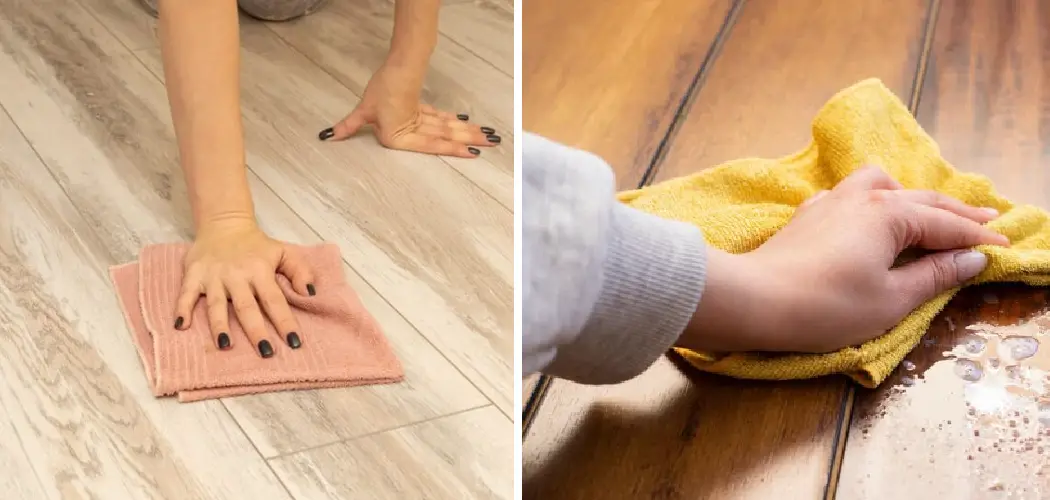Are you looking to restore your old hardwood floors and refresh the look of your home? Yellowing in wood flooring can take away from its original beauty, but luckily, this is a relatively simple fix.
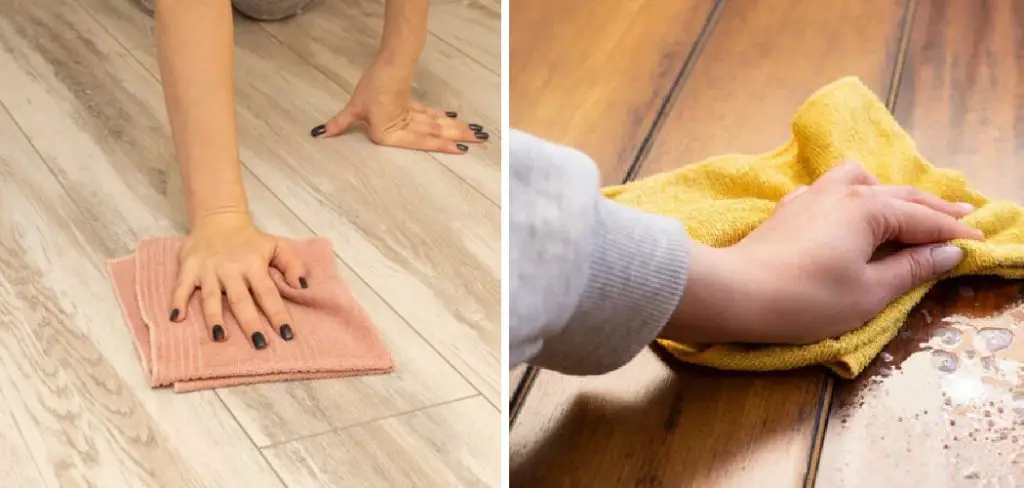
Yellowing can occur for several reasons, including exposure to sunlight, aging, or using the wrong cleaning products. No matter the cause, you can try a few methods to remove yellowing from hardwood floors and bring back the natural shine.
Here’s a guide on how to remove how to remove yellowing from hardwood floors so you can put the life back into them! With just a few basic items like vinegar, baking soda, steel wool pads, olive oil, and some elbow grease, you’ll have your hardwood floors back to their beautiful state in no time.
What Will You Need?
Before we get into the methods, having all the necessary items on hand is important. Here’s what you’ll need:
- White vinegar
- Baking soda
- Steel wool pads
- Olive oil
- Soft cloths
- Vacuum cleaner or broom
- Water and a bucket
Once you have everything, you’re ready to get started!
10 Easy Steps on How to Remove Yellowing From Hardwood Floors
Step 1. Prepare the Area:
First, you’ll need to prepare your hardwood floor for cleaning. Start by sweeping or vacuuming the area to remove any dust or debris. This helps to prevent scratching the floor during the de-yellowing process.
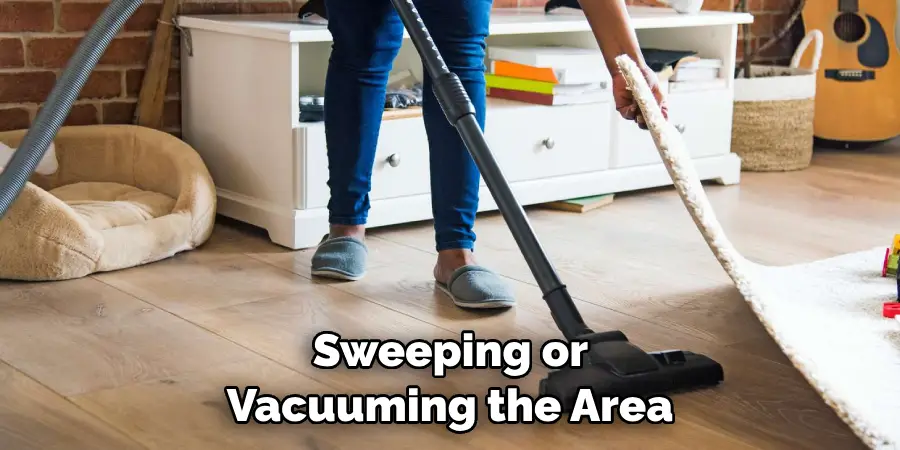
Step 2. Mix the Cleaning Solution:
Next, prepare your cleaning solution. In a bucket, mix equal parts of white vinegar and water. This simple, homemade solution effectively removes the yellow tinge from your hardwood floors without causing any damage. It’s important to remember that hardwood floors are sensitive to moisture, so be careful not to use too much water.
Step 3. Apply the Cleaning Solution:
Now, it’s time to apply the cleaning solution to your yellowed hardwood floors. Dip a soft cloth into your vinegar and water mixture, wring out the excess moisture, and gently wipe down the area of the yellowed floor. Remember to follow the direction of the wood grain to avoid causing any damage. After you’ve cleaned the entire area, leave it to dry naturally.
Step 4. Scrub the Hardwood Floor:
Once the floor is dry, it’s time to scrub the yellowed areas using a steel wool pad. Take your steel wool pad and gently start scrubbing the yellowed areas, following the direction of the wood grain. This will help to remove the yellowing without scratching or damaging the surface of your hardwood floors. Remember to use light pressure, as too much can cause scratches. After scrubbing, sweep or vacuum the area to remove any residue.
Step 5. Apply Baking Soda:
After scrubbing the floor, another method to help remove the remaining yellow staining is to apply baking soda. Sprinkle a generous amount of baking soda over the affected area and leave it to sit for about 15 to 20 minutes. The baking soda is a mild abrasive and helps lift the yellowing from the hardwood floor.
Step 6. Rinse the Floor:
Next, you need to rinse the floor to remove the baking soda. Make sure to use a damp cloth to do this, not a soaking wet one, as too much water can damage your hardwood floors. Wipe the floor following the grain of the wood. Once done, dry the floor using a soft cloth or mop.
Step 7. Polish the Floor:
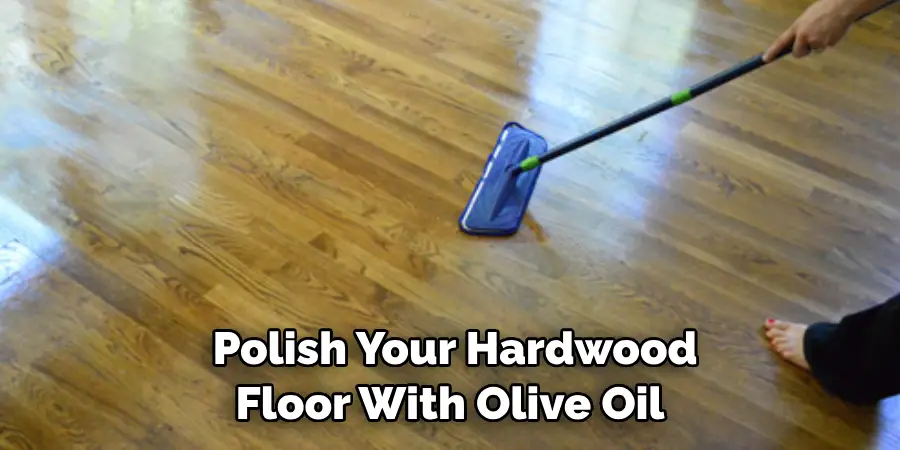
For the final touch, polish your hardwood floor with olive oil. Apply a small amount of olive oil to a soft cloth and wipe it over the floor, again following the direction of the wood grain. The olive oil gives your floor a beautiful shine and helps moisturize and protect the wood.
Step 8. Let the Floor Dry:
Allow your floor to dry completely. This may take a few hours, but it’s important to ensure no moisture remains that could damage your hardwood floor. Once the floor is dry, you should see a significant reduction in yellowing. If the yellowing is still visible, repeat the steps above until you achieve the desired results. Each hardwood floor and yellowing situation is unique; removing all the yellowing may take a few attempts.
Step 9. Maintain Regular Cleaning:
To prevent future yellowing, regularly clean your hardwood floors using appropriate products. Avoid using harsh chemicals and excessive water, and consider using blinds or curtains to protect your floors from direct sunlight, which can cause yellowing. Remember, proper care and maintenance can preserve the beauty of your hardwood floors for many years.
Step 10. Regularly Reapply the Floor Finish:
Lastly, consider periodically reapplying the floor finish to your hardwood floors. This can help to protect the wood from discoloration, scratches, and other types of damage.
Always use a finish that’s specifically made for hardwood floors, and follow the manufacturer’s instructions on how to apply it correctly. This step is crucial for high-traffic areas, which are more prone to yellowing. With the right care, your hardwood floors will maintain their beauty and shine for years.
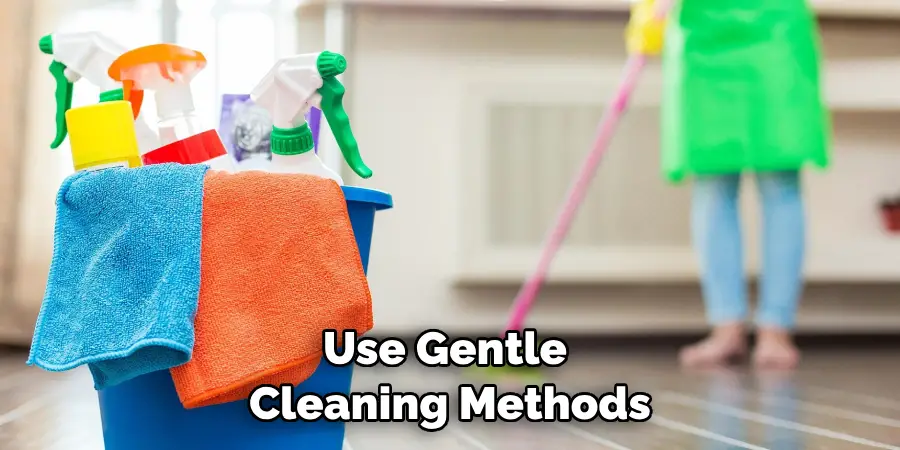
Following these simple steps, you can easily remove yellowing from your hardwood floors and restore their natural beauty. Remember to use gentle cleaning methods and avoid harsh chemicals or excessive water, which can cause damage.
5 Additional Tips and Tricks
- Frequent Dusting: Regularly dusting your hardwood floors can help prevent the buildup of dirt and grime that can contribute to yellowing.
- Avoid Sunlight: Direct sunlight can cause hardwood floors to discolored and yellow over time. Blinds, curtains, or other window treatments can help protect your floors from excessive sunlight.
- Waxing: Waxing your floors can help to create a protective barrier, preventing damage and yellowing. Always choose a wax designed specifically for hardwood floors to avoid damage.
- Proper Cleaning Solutions: Always use cleaning solutions designed for hardwood floors. Other harsh cleaners can strip the finish and cause yellowing.
- Annual Refinishing: Consider getting your hardwood floors professionally refinished every few years. This process will remove the old finish (which could be yellowing) and replace it with a fresh, clear coat.
With these additional tips and tricks, you can keep your hardwood floors looking clean and pristine for years. Remember, prevention is key when it comes to yellowing, so take steps to protect your floors before they start showing signs of discoloration.
5 Things You Should Avoid
- Avoid Spills: Water and other liquids can seep into the wood, causing discoloration and yellowing. Clean up spills immediately to prevent damage.
- Avoid Dragging Furniture: Dragging furniture across your hardwood floors can cause scratches that, over time, can discolor and lead to yellowing. Always lift and move furniture carefully.
- Avoid High Heels and Pet Claws: Both can cause scratches and dents on your hardwood floors’ surface, eventually leading to yellowing. Make sure to trim your pet’s nails regularly and avoid wearing high heels indoors.
- Avoid Using Bleach or Ammonia-Based Cleaners: These harsh cleaners can degrade the finish of your hardwood floors, leading to discoloration and yellowing over time.
- Avoid Excessive Wet Mopping: While keeping your hardwood floors clean is important, too much water can damage the wood and cause it to turn yellow. Always thoroughly wring out your mop to avoid applying too much water to the floor.
By avoiding these common pitfalls, you can maintain the natural beauty of your hardwood floors, preventing unsightly yellowing and preserving their beauty for many years.
What is the Best Natural Cleaner for Hardwood Floors?
While many commercial cleaners are available for hardwood floors, some people prefer to use natural cleaning solutions. One of the best options is a mixture of equal parts water and vinegar. This solution can help remove dirt and grime without damaging the finish or causing yellowing. Simply mix in a spray bottle, lightly mist your floor, and then mop with a damp cloth. Add a few drops of essential oils, like lemon or lavender, for a pleasant scent.
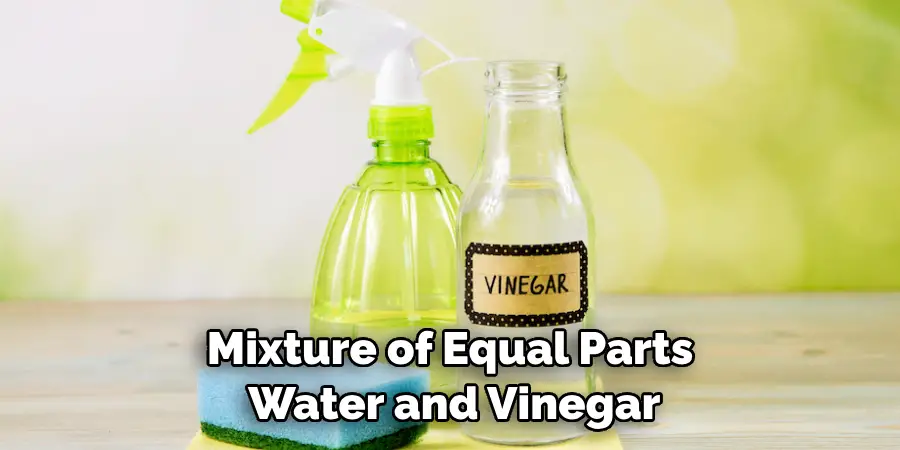
Another natural option is using black tea. Brew some strong black tea and let it cool before applying it to your hardwood floors with a cloth or mop. The tannic acid in the tea acts as a gentle cleaner and can help remove any buildup that may be causing yellowing.
No matter which cleaning solution you choose, always test it in a small, inconspicuous area first to ensure it doesn’t cause any damage or discoloration. And remember, prevention is key when it comes to maintaining the natural beauty of your hardwood floors.
What Not to Use on Hardwood Floors?
In addition to the things listed above, there are a few specific products that you should avoid using on your hardwood floors. These include:
- Steam Mops: The high heat and moisture from steam mops can cause damage and discoloration to your hardwood floors.
- Vinegar and Oil Solutions: While vinegar is safe for hardwood floors, combining it with oil (such as olive or vegetable oil) can create a sticky residue that is difficult to remove.
- Bleach and Ammonia-based Cleaners: As mentioned above, these harsh chemicals can strip the finish of your hardwood floors, causing damage and yellowing.
- Floor Wax Removers: If you choose to wax your floors, avoid using wax removers, as they can cause damage and discoloration.
By being mindful of what products you use on your hardwood floors, you can prevent potential damage and keep them looking beautiful for years. Regular maintenance, proper cleaning techniques, and avoiding harsh chemicals are key to removing yellowing and maintaining the natural beauty of your hardwood floors.
Does Hot Water Damage Wood Floors?
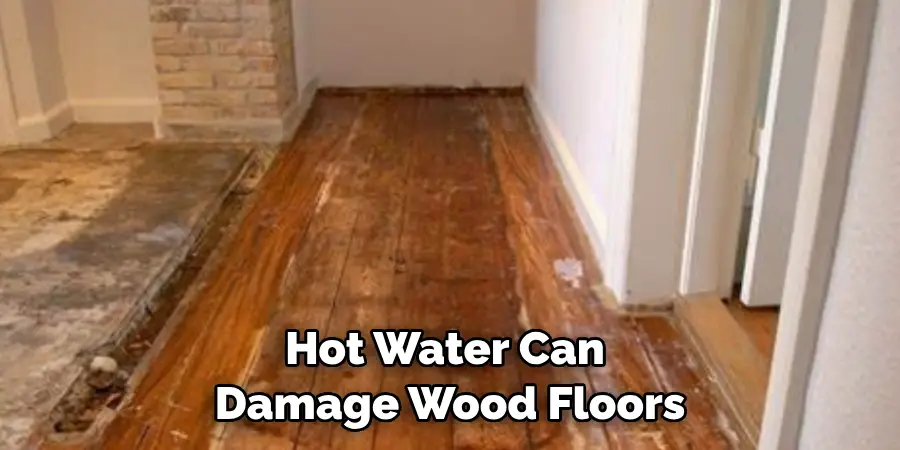
Yes, hot water can damage wood floors. Excessive heat and moisture can cause the wood to warp and buckle, leading to permanent damage. When cleaning your hardwood floors, always use room temperature or lukewarm water, never hot. Additionally, avoid using steam mops or excessive water when mopping to prevent damage.
With these helpful tips and tricks, you can confidently maintain your hardwood floors and remove any yellowing that may occur. By being proactive and avoiding common causes of discoloration, you can keep your floors looking new for years to come.
Remember, prevention is key to preserving the natural beauty of your hardwood floors.
Conclusion
All in all, when it comes how to remove yellowing from hardwood floors, there are a few different ways that you can go about removing it. Understanding the causes and how to take preventative measures can go a long way in maintaining your floor’s beauty for many years. You can spot treat yellowed areas with the right sand and steel wool or use wood bleach for more intense situations.
Natural products like lemon juice and baking soda mix can help restore brightness and beauty in hardwood floors. With careful consideration and diligence, you will be sure to keep your floors looking great and make them last longer.
But overall, remember that regular maintenance is the key to keeping your hardwood floors attractive over the years. So why not take the time now to ensure your hardwood floors regain their original shine? There is no better time than now!

